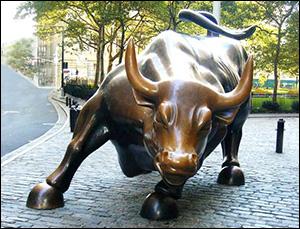By Pam Martens and Russ Martens: December 30, 2016
We have noticed throughout this past year that when the Standard and Poor’s 500 index of stocks sold off, big banks’ share prices sold off by dramatically more on a percentage basis. Yesterday, notwithstanding the big rally bank stocks have enjoyed since Donald Trump’s win on November 8, the big banks once again dramatically outpaced the S&P 500 on the downside. The S&P lost 0.03 percent while the major Wall Street banks like Citigroup, Goldman Sachs, Morgan Stanley and Bank of America lost over 1 percent. It was a worthwhile reminder that the hurdles the big banks have experienced this year have not diminished – by any means.
As 2016 began, the big, globally-interconnected Wall Street banks were facing serious headwinds. The Fed had just hiked rates and oil prices could not find a floor and neither could the share prices of these banks, which had heavy loan exposure to the energy sector. By January 20, Citigroup, Morgan Stanley, Goldman Sachs and Bank of America were trading at new 12-month lows.
As oil prices recovered from the $30 range to the $50 range in the Spring, bank stocks rallied as well. Then came the Brexit vote shocker in the U.K. on June 23. In New York trading the day after the vote, bank stocks were pummeled. While the Dow Jones Industrial Average lost only 3.39 percent, Morgan Stanley shed 10.15 percent; Citigroup slumped 9.36 percent; Bank of America was down 7.41 percent while Goldman closed with a loss of 7.07 percent.
Wall Street On Parade also paid close attention to the trading action of MetLife, the large insurer, on the Friday after the Brexit vote. The company is battling its designation as a Systemically Important Financial Institution (SIFI) at the Appellate Court level after winning against the U.S. government at the District Court. In a single trading session on Friday after the Brexit vote, MetLife lost even more than Morgan Stanley, shaving 10.71 percent off its market value.
What all of these bank stocks and MetLife have in common are large exposures to derivatives. (While JPMorgan Chase typically sells off less than the other bank stocks, it also has a massive derivatives book.)
On December 18, 2014, when the Financial Stability Oversight Council (F-SOC) released its report on why it was designating MetLife a SIFI, it pointed out the following:
“MetLife leads the U.S. life insurance industry in certain institutional products and capital markets activities, such as issuances of funding agreement-backed notes (FABNs), guaranteed minimum return products (such as general and separate account GICs), and securities lending activities. These activities expose other market participants to MetLife and create on– and off– balance sheet liabilities that increase the potential for asset liquidations by MetLife in the event of its material financial distress. Efforts to hedge such risks through derivatives and other financial activities are imperfect and further increase MetLife’s complexity and interconnectedness with other financial markets participants…”
The report also found that MetLife made repeated use of the emergency bailout mechanisms during the 2008 financial crisis, writing:
“During 2008 and 2009, MetLife’s subsidiary bank accessed the Federal Reserve Term Auction Facility 19 times for a total of $17.6 billion in 28- day loans and $1.3 billion in 84-day loans. In March 2009, MetLife raised $397 million through the Temporary Liquidity Guarantee Program run by the Federal Deposit Insurance Corporation (FDIC), which enabled the organization to borrow funds at a lower rate than it otherwise would have been able to obtain. Additionally, MetLife borrowed $1.6 billion through the Federal Reserve’s Commercial Paper Funding Facility.”
F-SOC made the determination that “material financial distress at MetLife could pose a threat to U.S. financial stability.” Underscoring that point, it noted:
“Large financial intermediaries, including global systemically important banks (G-SIBs) and global systemically important insurers (G-SIIs), have significant exposures and interconnections to MetLife through its institutional products and capital markets activities.”
The so-called Trump rally in bank stocks was always suspect. Trump’s promise to shred key provisions of the Dodd-Frank financial reform legislation without any stated plan as to how Wall Street would be regulated going forward should have been a negative, not a positive, in the stock market. More problematic, the Federal Reserve has very little room for error this time around. It can’t launch a multi-year easing program when it has only two interest rate cuts available in its monetary arsenal and the headwind of a $4.5 trillion balance sheet accumulated to prop up banks in the last crash.
On top of this, the giant German bank, Deutsche Bank, which the International Monetary Fund called “the most important net contributor to systemic risks” in a report in June, still has not formally settled its alleged mortgage fraud case with the U.S. Justice Department and remains under multiple investigations for potential currency market rigging and so-called mirror trades that moved billions of dollars out of Russia.
And despite the largest taxpayer-financed global bank bailout in history just eight years ago, a brand new massive taxpayer bailout is underway in Italy to rescue yet another grossly mismanaged global bank.
Both the Democratic and Republican platforms this year included a goal of restoring the Glass-Steagall Act, which would separate today’s casino banking model from banks holding taxpayer-backed insured deposits — ending the era of heads we win, tails you lose. If President-elect Donald Trump has any hope at all of surviving the next four years without another banking panic and meltdown, he needs to make the restoration of Glass-Steagall a top priority from day one.


